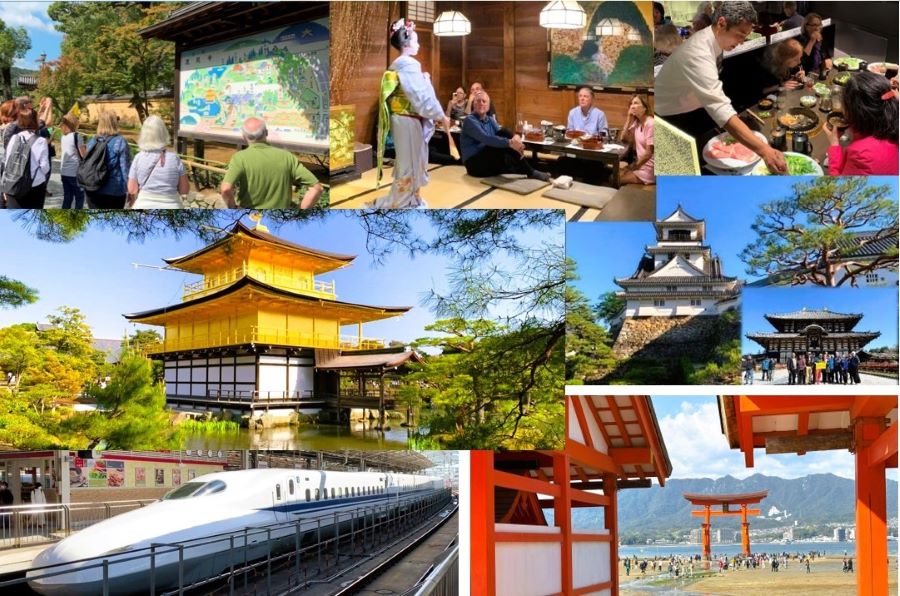
If you are looking for Japan tours from Toronto, you’ve just found the right tour company in Laurus Travel. We specialize in premium small-group tours to Asia and Japan is one of our key destinations. Our guided tours to Japan feature outstanding guides, small group size, both Japanese and Western gourmet meals, and premium accommodations. Laurus Travel’s Japan tours strive to offer the participant a deep insight into Japan with a strong emphasis on culture and history.
We have a number of Japan tour itineraries currently available including the popular 14-day Best of Japan below.
Best of Japan (14 days)
Tokyo – Mt. Fuji – Hakone – Kanazawa – Takayama – Shirakawa-go – Kyoto – Nara – Osaka – Hiroshima – Miyajima – Tokyo
With a focus on history and culture, this premium small-group Japan tour showcases the best of the Land of the Rising Sun. From the present capital of Tokyo to the former imperial seat of Kyoto, Japan’s illustrious blend of ancient traditions with state-of-the-art modernity is on full display.
Important Features
- Small group size – average 16, maximum 20
- Experienced professional guides
- Premium hotel accommodations
- Quality Japanese & Western cuisines
- Sushi making lesson
- Kaiseki dinner with geisha dancer (maiko) performance
- Sukiyaki or BBB dinner featuring premium Japanese beef
- No shopping stops
Meal Code: B = breakfast / L = lunch / D = dinner
Day 1/Mon: Departing Home City
The journey begins with your transpacific flight departing from a city of your choice. You’ll lose a day upon crossing the International Date Line.
Day 2/Tue: Arrival in Tokyo
Welcome to Tokyo!
Please make your way to the hotel on your own. Detailed up-to-date information on how to get to the hotel will be provided in the final update two weeks before departure. Private transfer can be arranged on request.
Day 3/Wed: Tokyo (B/L)
Tokyo, literally meaning “eastern capital” and officially named Tokyo Metropolis, is one of the most populous mega-cities in the world with a population of 14 million. Formerly known as Edo, the city has been the de facto seat of the Japanese government since 1603 when shogun Tokugawa Ieyasu chose the city for his headquarters. The shogun (general) was a hereditary commander ceremoniously appointed by the emperor but held real power over the country during the shogunate period between 1192 and 1867. Edo was renamed Tokyo after Emperor Meiji moved his seat from Kyoto in 1868 when the last shogun was forced to return power to the imperial court. The city covers an area of 2,187 square kilometres following the merger in 1943 of the city of Tokyo and Tokyo Prefecture.
Our full-day sightseeing begins at the plaza in front of the Imperial Palace. The palace is closed to tourists but a stroll across the plaza accompanied by commentaries on the imperial family and the city of Tokyo gets the tour off to a good start.
We then proceed to Senso-ji, the oldest Buddhist temple in Tokyo dating back to 628.
After lunch, we drive through the ritzy Ginza shopping district on the way to Meiji Jingu, a Shinto shrine dedicated to Emperor Meiji (1852 -1912) and his wife.
We end the day with a visit to the observation deck atop the Tokyo Metropolitan Government Building in Shinjuku. On a clear day, the visitor could see the peak of Mount Fuji about 84 km to the west. The building complex completed in 1990 at a cost of US$1 billion consists of three main structures each taking up a city block. The architect of the Tokyo Metropolitan Government Building is Kenzo Tange (1913 – 2005), who in 1987 became the first Japanese to win the Pritzker Prize for Architecture.
Day 4/Thu: Tokyo – Mt. Fuji – Hakone – Tokyo (B/L)
We depart at 7:30 AM for a full-day excursion to Mt Fuji and Hakone.
Mt. Fuji, the highest mountain (3,776 metres) in Japan, is a two-hour drive from Tokyo. We stop by the Fujisan World Heritage Center to view the summit and learn about the history, formation and ecology of Mt. Fuji through exhibits and a short film. However, it is purely a matter of luck whether the summit is visible as Mt. Fuji is often shrouded in clouds. Our schedule does not include hiking the mountain – the trails are open between July and early September and it would take the average person at least six hours to hike to the summit even if one starts from the highest station at 2,305 metres above sea level.
We then proceed to Lake Ashi in Hakone for a short cruise across the lake. This is followed by a 10-minute cable car ride that transports us to the station overlooking the sulphur-spewing Owakudani Geothermal Valley. On a clear day, the cable car ride provides stunning views of Mt. Fuji and its surrounding mountain slopes.
Japan Tours from Toronto – Q&A
Do I need a visa to visit Japan?
Canadian tourists do not need visa to enter as long as the stay is within 90 days.
Can Laurus Travel book my airfare?
Absolutely! If you want to fly business class or premium economy, you would be delighted by what we can find you. Our expertise really works.
Should I get Japanese yen before arrival in Japan
Your Canadian bank is among the worst places for currency exchange. Independent dealers can easily beat your bank but you must shop around and avoid currency dealers catering to tourists. In our opinion, it is better to wait until after arrival in Japan to obtain yen, which can be easily done through local ATMs using your debit card issued in Canada. You’ll receive more advice on this once you sign up with us.
Can I use credit cards in Japan?
Today, credit cards including those issued overseas are accepted almost everywhere in Japan including small restaurants and convenience stores.
More questions? Just let us know.


